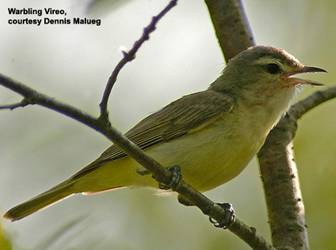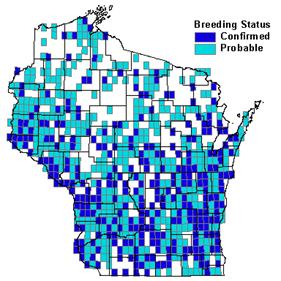Photo by Dennis Malueg


Status/Protection
- Global Rank: G5 Key to global and state ranks
- State Rank: S4B
- WBCI Priority: PIF
Population Information
Federal BBS information can be obtained at http://www.mbr-pwrc.usgs.gov/bbs/bbs.html by clicking on Trend Estimates and selecting the species in question. All estimates are for 1966-2005.
- Federal Breeding Bird Survey: significant increase
- Federal Breeding Bird Survey (WI): non-significant decline
- Federal Breeding Bird Survey (BCR 23): non-significant decline
- Federal Breeding Bird Survey (BCR 12): non-significant decline
- WSO Checklist Project: increase (1983-2007)
Life History
- Breeding Range: Southeast Alaska west across southern Canada and the northern half of the U.S. to the Atlantic Coast (Gardali and Ballard 2000).
- Breeding Habitat: Bottomland Hardwood, Central Hardwood, Shrub-Carr, Alder Thicket, riparian woodlands with scattered large trees.
- Nest: Hanging cup, 1-37 meters above ground.
- Nesting Dates: Eggs: Late May to late June (Robbins 1991).
- Foraging: Foliage glean, hovers.
- Migrant Status: Neotropical migrant, medium-range migrant.
- Habitat use during Migration: Wide range of forested and shrubby habitats.
- Arrival Dates: Early to late May (Robbins 1991).
- Departure Dates: Mid-August to mid-September (Robbins 1991).
- Winter Range: Western Mexico and northern Central America.
- Winter Habitat: Wide range of forested habitats, including plantations.
Habitat Selection
Throughout their range, Warbling Vireos are strongly associated with mature mixed deciduous woodlands, especially in riparian areas (Gardali and Ballard 2000). In Wisconsin they inhabit a wide variety of habitat types, with more than 100 habitat codes described during the Wisconsin Breeding Bird Atlas (Harriman 2006). Overall habitat structure typically consists of large trees with a semi-open canopy, either in the forest interior or along edges and openings. Warbling Vireos are not considered to be area-sensitive and will nest in forest fragments and remnants of almost any size (Bent 1950, Gardali and Ballard 2000). Nests are often placed in the periphery of a shrub or tree, usually supported by two lateral limbs (Gardali and Ballard 2000). In Wisconsin, elm, maple, willow or poplar are common nest trees (Robbins 1991).
Habitat Availability
Although this species is largely a habitat generalist, habitat loss resulting from agricultural and urban expansion may have negative impacts. Southern Wisconsin forests have experienced significant loss and fragmentation since pre-settlement times (Mossman 1988, WDNR 1995). Current forest management practices, grazing, and invasive species have altered the composition and structure of remaining southern forests (WDNR 2005). However, it is not well-known how these changes affect Warbling Vireos.
Population Concerns
Population trends are variable across this species’ range. Breeding Bird Survey (BBS) data suggest a significant annual increase range-wide but a non-significant decline in Wisconsin (Sauer et al. 2005). It is considered a common summer resident and breeder throughout most of Wisconsin (Robbins 1991). During the six-year period of the Wisconsin Breeding Bird Atlas, observers recorded evidence of breeding in 69% of the surveyed quads (Harriman 2006).
Eastern populations of Warbling Vireo appear to be less frequently parasitized by Brown-headed Cowbirds compared to western populations (Sealy et al. 2000). No parasitism, for example, was found in 43 nests in studies from Michigan, Kansas, and Illinois (Sutton 1949, Johnston 1964, Graber et al. 1985). Nest depredation is a significant limiting factor in many western populations, but this is not well-studied for eastern populations. Habitat loss on the wintering grounds may be impacting this species (Gardali and Ballard 2000). Indiscriminate spraying to combat gypsy moth larva could adversely affect other caterpillar species, thus reducing available prey (Harriman 2006).
Recommended Management
Management efforts that protect tracts of mature deciduous forests, particularly riparian woodlands, will likely benefit this species. Within known breeding areas, managers should retain scattered large trees, particularly elm, maple, poplar, and willow. Warbling Vireos have shown positive responses to bottomland hardwood restoration in the southern U.S. (Twedt et al. 2002) and would likely benefit from similar efforts in Wisconsin. Areas with a high potential for restoration, such as young stands or small tracts of deciduous forest in southern Wisconsin, should be identified and considered for future restoration.
Research Needs
Limiting factors on both the breeding and wintering grounds are poorly known. In Wisconsin, studies investigating nest depredation and brood parasitism rates within different habitat types may help to elucidate reasons for possible statewide decline. Although tolerant of edges and human-altered landscapes, reproductive success should be measured to determine the true suitability of these habitats.
Information Sources
- Chequamegon National Forest Bird Survey (NRRI) species account: http://www.nrri.umn.edu/mnbirds/accounts/WAVIa2.htm
- Cornell Lab of Ornithology species account: http://www.birds.cornell.edu/AllAboutBirds/BirdGuide/Warbling_Vireo.html
- Nicolet National Forest Bird survey map: http://www.uwgb.edu/birds/nnf/species/WAVI.htm
- North American Breeding Bird Survey: http://www.mbr-pwrc.usgs.gov/bbs/bbs.html
- Patuxent Bird Identification Center: http://www.mbr-pwrc.usgs.gov/id/framlst/i6270id.html
- Temple S.A., J.R. Cary, and R. Rolley. 1997. Wisconsin Birds: A Seasonal and Geographical Guide. Wisconsin Society of Ornithology and Wisconsin Department of Natural Resources, Madison, WI.
- Wisconsin Breeding Bird Atlas: http://www.uwgb.edu/birds/wbba/
References
- Bent, A.C. 1950. Life histories of North American wagtails, shrikes, vireos, and their allies. U.S. Natl. Mus. Bull. 197.
- Gardali, T. and G. Ballard. 2000. Warbling Vireo. In The Birds of North America, No. 551 (A. Poole and F. Gill, eds.). The Birds of North America, Inc., Philadelphia, PA.
- Graber, J.W., R. R. Graber, and E. L. Kirk 1985. Illinois birds: vireos. Ill. Nat. Hist. Surv. Biol. Notes no. 124.
- Harriman, N.A. 2006. Warbling Vireo. In The Wisconsin Breeding Bird Atlas (N.J. Cutright, B.R Harriman, R.W Howe, eds.) The University of Wisconsin Press: Madison, WI.
- Johnston, R.F. 1964. The breeding birds of Kansas. Univ. Kans. Publ. Mus. Nat. Hist. 12: 575–655.
- Mossman, M. 1988. Birds of southern Wisconsin floodplain forests. Passenger Pigeon 50(4): 321-337.
- Robbins, S.D., Jr. 1991. Wisconsin birdlife: Population and distribution past and present. Madison, WI: Univ. Wisconsin Press.
- Sauer, J.R., J.E. Hines, and J. Fallon. 2005. The North American Breeding Bird Survey, Results and Analysis 1966 - 2005. Version 6.2.2006. USGS Patuxent Wildlife Research Center, Laurel, MD.
- Sealy, S.G., A.J. Banks, and J.F. Chace. 2000. Two subspecies of Warbling Vireo differ in their responses to cowbird eggs. Western Birds 31: 190-194.
- Sutton, G.M. 1949. Studies of the nesting birds of the Edwin S. George Reserve. Pt. 1: the vireos. Univ. Mich. Mus. Zool. Misc. Publ. no. 74.
- Twedt, D.J., R.R. Wilson, J.L. Henne-Kerr, and D.A. Grosshuesch. 2002. Avian response to bottomland hardwood reforestation: The first 10 years. Restoration Ecology 10(4): 645-655.
- Wisconsin Department of Natural Resources (WDNR). 1995. Wisconsin’s Biodiversity as a Management Issue. http://dnr.wi.gov/org/land/er/biodiversity/report.htm
- Wisconsin Department of Natural Resources (WDNR). 2005. Wisconsin’s Strategy for Wildlife Species of Greatest Conservation Need. Madison, WI.
Contact Information
- Compiler: Tom Klubertanz, tklubert@uwc.edu
- Editors: Kim Kreitinger, K.Kreitinger@gmail.com
